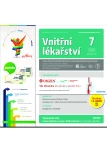-
Medical journals
- Career
ERCP in patients after choledochodenoanastomosis
Authors: Bohuslav Kianička 1; Martin Blaho 2; Lumír Kunovský 3,4; Miroslav Souček 1; Petr Piskač 5; Petr Vlček 5
Authors‘ workplace: II. interní klinika LF MU a FN U sv. Anny v Brně 1; Gastroenterologické oddělení Interní kliniky LF OU a FN Ostrava 2; Interní gastroenterologická klinika LF MU a FN Brno, pracoviště Bohunice 3; Chirurgická klinika LF MU a FN Brno, pracoviště Bohunice 4; I. chirurgická klinika LF MU a FN u sv. Anny v Brně 5
Published in: Vnitř Lék 2020; 66(7): 26-30
Category: Original Contributions
Overview
The aim of this retrospective study is to evaluate our experience with diagnostic and therapeutic endoscopic retrograde cholangiopancreaticography (ERCP) in patients after choledochoduodenoanastomosis.
Methods: The study took 20 years (November 1994 – December 2014). Three patients after choledochoduodenoanastomosis who had symptoms of biliary obstruction were retrospectively evaluated. In all cases, a standard therapeutic videolateroscope was used to perform ERCP.
Patients and results: We achieved ERCP in these 3 patients with choledochoduodenoanastomosis 100% cannulation success rate – 3 out of 3 patients. This was 100% success rate of diagnostic ERCP. In all of these patients, ERCP was found – both stenosis of the natural mouth of the Vater papilla, stenosis of choledochoduodenoanastomosis, and suprastenotic distal choledocholithiasis. In all patients with the above-described ERCP pathology, endoscopic treatment was initiated immediately after diagnostic ERCP, consisting of standard endoscopic papillotomy of the stenotic Vater papilla, balloon dilatation of choledochoduodenoanastomosis stenosis, and endoscopic extraction of suprastenotic distal choledocholithiasis. In total, therapeutic ERCP was completely successful in all 3 patients out of 3 (100%) who had initially started endoscopic treatment. There were no complications in our group of 3 patients.
Conclusion: In ERCP in patients after choledochoduodenoanastomosis, we achieved 100% success of both diagnostic and therapeutic ERCP in all of our 3 patients.
Keywords:
endoscopic diagnostics – endoscopic retrograde cholangiopancreatography – endoscopic treatment – choledochoduodenoanastomosis
Sources
1. Vavrečka A, et al. Diagnostická a liečebná endoskopie žlčových ciest a pankreasu. Bratislava: Osveta 1988.
2. Keil R, Lochmanová J, Námešný I, et al. Řešení benigních stenóz žlučových cest. Miniinvazivní terapie 1998; 3 : 33–35.
3. Keil R. Akutní biliární pankreatitida – endoskopická terapie ano nebo ne? Vnitř Lék 2002; 48 : 847–850.
4. Zbořil V, Cigánková E, Studeník P, et al. ERCP v diagnostice a terapii komplikací jaterních transplantací. Čes Slov Gastroent 1999; 53 : 47–50.
5. Procházka V, Konečný M, Král V, et al. ERCP v diagnostice a léčbě biliárních komplikací laparoskopické cholecystektomie. Čes Slov Gastroent 1999; 53 : 140–144.
6. Jurgoš L, Kužela L, Hrušovský Š, et al. Gastroenterológia. 1. vyd. Bratislava: Veda 2006.
7. Novotný I. Pankreatobiliární terapeutická endoskopie u pacientů geriatrického věku. Čes Ger Rev 2007; 5 : 78–84.
8. Suisse A, Yassin K, Lavy A, et al. Outcome and early complications of ERCP: a prospective single center study. Hepatogastroenterology 2005; 52 : 352–355.
9. Caroli-Bosc FX, Demarquay JF, Peten EP, et al. Endoscopic management of sump syndrome after choledochoduodenostomy: retrospective analysis of 30 cases. Gastrointest Endosc 2000; 51 : 180–183.
10. Lo SK. ERCP in surgicaly altered anatomy. In: Baron T, Kozarek R, Carr-Locke D ERCP. 1st ed. Philadelphia, PA: Saunders Elsevier, 2008 : 237–258.
Labels
Diabetology Endocrinology Internal medicine
Article was published inInternal Medicine

2020 Issue 7-
All articles in this issue
- Coagulopathy associated with COVID-19
- Current diagnosis and therapy in sarcoidosis
- Obstructive sleep apnea and hypertension: the role of gut microbiome
- CAR T-cells: hot news in cancer therapy
- Renal failure in multiple myeloma and its treatment
- Bone Metabolism in Inflammatory Bowel Diseases 2
- Metformin -associated lactic acidosis
- Tangier disease in family with the phenotype of familial hypercholesterolemia
- Hypoglycemia in non -diabetic patients
- Screening and brief intervention in illicit drug users
- Bone metabolism in inflammatory bowel diseases 1
- Ethical connotations of the treatment of COVID-19 disease
- Biomarkers for non-endoscopic examination of esophageal mucosa
- Risk of cardiovascular complications related to blood glucose concentration: from diabetes to prediabetes
- ERCP in patients after choledochodenoanastomosis
- Rationed nursing care as one of the indicators of the occurrence of medication errors
- A rare coincidence of a chylothorax and a hydrothorax caused by gastric adenocarcinoma – a case report
- A man with dysthymia (with negative evaluation of allmost all through his live) induced depression in his sensitive spouse
- Small bowel adenocarcinoma diagnosed by video capsule endoscopy in a patient with celiac disease: a case report and review of literature
- Internal Medicine
- Journal archive
- Current issue
- Online only
- About the journal
Most read in this issue- Hypoglycemia in non -diabetic patients
- Metformin -associated lactic acidosis
- Coagulopathy associated with COVID-19
- CAR T-cells: hot news in cancer therapy
Login#ADS_BOTTOM_SCRIPTS#Forgotten passwordEnter the email address that you registered with. We will send you instructions on how to set a new password.
- Career

